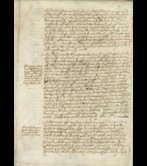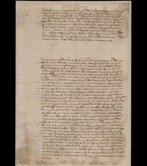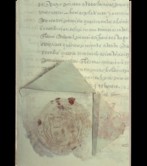Institutional development
Institutionalisation of the General Councils and Local Governments
The importance and development of the Provincial Government made it necessary to institutionalise the Local Government as a body that enforced the legal regulations laid down by the Councils. Some authors defend the existence of members of parliament or commissioners in charge of enforcing the decisions and agreements reached by the Councils as far back as the 15th century, although this institutionalisation has been situated in the 16th century, possibly due to the importance and development of the provincial government. In this way, in 1549 a request was recorded, implemented in April 1550, to appoint general members of parliament, enforcing the Council's decrees. This figure of member of parliament was also rotated, depending on the Magistrate's town of residence (San Sebastian, Tolosa, Azpeitia and Azkoitia), which was also temporary. The first member of parliament elected in this way was Joan López de Olazábal, Mayor of Tolosa who would substitute Martín Ibáñez de Jausoro when the Magistrate was moved to Azkoitia. This system took 4 or 5 years to get up and running but it was clearly successful from 1567 when, in addition to the member of parliament, it designated an entire collegiate institution, the Local Government, made up of four members of parliament chosen by each Council from among the most important men in the rotating towns (San Sebastián, Tolosa, Azpeitia and Azkoitia) - in the name of the Province - including the Magistrate - in the name of the monarch - and the regiment of the corresponding town - in the name of the towns.
In this period, the General Councils were strengthened and became a key element for the Crown of Castile to defend the territory. They essentially continued to work and be organised in the same way as the previous period although some changes were made. They had also been extending their powers protected by the new political and economic situation. The voting system in the Juntas Generales (General Committees) was strengthened, though not without creating tension, as some villas were more powerful than others, and each villa voted according the the number of fuegos (families). Thus San Sebastián, Tolosa, Segura and Ordizia, as well as having larger populations, especially in the case of the first two, had more votes because more hamlets were under their control. This doesn’t mean they were more representative of the inhabitants because at the same time each villa had developed its own internal institutions and become more “aristocratic”, and it is this economic elite, made wealthy by iron and trade – and often linked to the old Parientes Mayores – who held power, first locally and later at a provincial level.
In this period Gipuzkoa was bestowed with a new legal instrument that compiled and expressed the Regional Collection by Zandategui and Cruzat in 1583.One of the basic elements of the Provincial Government compared to the Crown of Castile was going to be the 'Pase Foral', namely the Councils' power to respect but not comply with the Crown's instructions that they considered to be contrary to Gipuzkoa's own code of laws.
Universal squirearchy
This aforementioned "aristocratising" process is accompanied by a concept that, whilst paradoxical in theory, was very effective in practice : the universal squirearchy. The squirearchy, the lowest grade of nobility, who were not obliged to pay personal taxes, was a status acquired by the villas in the 14th century, first in Tolosa and later across the rest of the province. By spreading the jurisdiction of the villas across the entire region, the rural settlements also benefited. Furthermore, starting from the traditional concept of the ancestral home and family ties, but with the villas’ social and economic initiative, a stratum of the nobility was created who manufactured (“worked with the hands”, in the language of the time) and traded (“owned a shop”). Peasant and noble, opposing concepts in Castile, form the juridical basis of Gipuzkoa.




